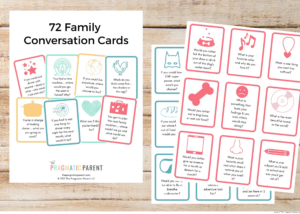Screen Time Rules for Kids: Printable Screen Time Rules. How to set clear guidelines around screen time use for kids so there’s zero guilt with electronics this Summer.

8 Smart Rules for Managing Screen Time This Summer
Summer is the most relaxed time of year, but that doesn’t mean your screen time rules should also relax or go away completely! It’s important to find a healthy balance between screen time and other activities, especially movement related.
There’s no better time than Summer to head outside with your kids for unstructured free play, spend time at the pool and do all the things they can’t during the winter months.
However, Summer is also a major juggling act for many parents who are trying to balance work with their children’s schedules and screen time can become a helpful babysitter when you need to jump on a zoom meeting or wrap up work.
Excess screen time can negatively impact children’s phsycial and mental well-being, but with firm strategies in place that everyone in your home understands and respects, you can ensure the balance of peace.
As you get into Summer, it’s okay to allow devices, but it’s also a good idea to set reasonable limits of their use so you don’t create a difficult habit to break down the road. After all, you don’t want entertainment via electronics to become a free-for-all for the next few months.
I don’t think anyone would agree that giving children free reign to tech while they binge on the ipad, video games, and the TV, no matter how educational they are, is a wise choice.
Let’s explore how to create an effective guideline for managing screen time this summer, while still fostering an enjoyable and active season for your kids.
8 Guidelines for Establishing Screen Time Limits
1. Establish Clear Boundaries with Electronics
Having clear boundaries by establishing defined guidelines for screen time means determining daily screen time limits, communicating them to all family members and sticking to it.
Around the dinner table, it’s a good time to talk about family screen time rules to ensure everyone has a crystal clear understanding of them and also what the consequences are if they’re broken or exceeded.
You can talk about what the time limit is, what the time can be used towards (is it for example, 60 minutes per devices or 60 minutes total that can be used for a TV show, xbox game and computer.) It’s also important to talk about how the time needs to be monitored.
At our house, everyone gets 60 minutes of screen time that can be used only after they have done 30 minutes of reading, their rooms are cleaned and all their chores are done. Then, each child has to come to Mom or Dad for permission to use electronics and we will start a timer on our phones with an alarm to tell us when the’ve used their time. When the alarm goes off on our phones, all the kids know it’s time to turn off whatever they’re on and that’s it for the day.
It’s up to you how much screen time you allow, but studies show a limit of 30-60 minutes daily is the right amount before sending your kids back outside to explore and play with friends.
The hardest part about setting clear expectations is two-fold:
- Staying firm about our rules to earn screen time, especially if one of the kids doesn’t do all their reading or chooses not to do their chores that day. Being the bad cop who doesn’t give in is a hard role to play sometimes.
- Moderating the time our kids are on electronics. This is also the most important part because if our kids didn’t see us follow through on a set time of usage, they’d be on electronics much longer than they’re allowed. This is an absolute must!
What definited daily limits can include:
- The amount of daily screen time each child gets
- What responsibilities/expectations you have to earn or receive screen time (if you choose to utilize)
- Screen-free zones and times
- How someone can lose screen time (if you choose to utilize)
2. First Encourage Physical Activity and Outdoor Play
I inwardly cringe whenever my kids beg for tv time and I’m looking out the window at what a beautiful day it is.
Summer gives you the perfect opportunity to get outdoors and be physically active! Encouraging kids to play outside, see if the neighbors want to ride their bikes, shoot hoops, go for a walk, engage in sports, or explore nature not only promotes health but mental wellness, creativity and imagination, too!
I encourage my kids to be outside and physically active, especially with friends, before they have any time of electronics and often find that they are so engaged with what they’re doing, it reduces their reliance on sceens.
3. Plan for Family Time to Reduce Desire for Screens
Being on a tablet or asking to watch tv is typically when I notice my kids are bored and looking for something to fill their time.
This is why planning regular activities and family time that doesn’t involve screens is important. Having family game night, conversation questions at mealtime, and arts and crafts you can do together is a positive distraction to reducing the desire for screens.
4. Responsibilities to Earn Kids Screen Time
Back when I was a kid, Summer meant entire days spent at the swimming pool, riding our bikes with friends, choreographing dances with the neighborhood girls and ghost stories after dark.
There wasn’t much in the way of screen time aside from the occasional game of Tetris on my Gameboy, Mario Brothers when you were at “the cool kid’s house” who had a Nintendo and TVs with only 8 -10 channels, not a bazillion like you see today.
Time certainly have changed, but Summers don’t have to!
To ensure your kids aren’t glued to devices all Summer long, it’s a good idea to create a checklist they need to complete each day, including chores, personal tasks and some educational and screen-less activities, before they can earn a set amount of screen team.
Here is a free printable of Screen Time Rules you can use at your house this summer, or during weekends, on school breaks (or closures and quarantine) too.
5. Set an End Time to All Electronics & a Screen-Free Zone
You can designate certain areas or times in your home that become screen-free zones. My son recently went a friends house for the night and his parents collected the boy’s phones early in the night so there’d be no electronics available after bedtime or when they were unsupervised. I thought this was so smart!
I set downtime on all phones in our house after 8pm, but we also instituted the shut down of television 45 minutes before bedtime. The kids can either read a book or be in their rooms or we sit together as family and just talk and share what’s on our hearts – the only rule is no electronics or screens of any type!
You can designate no screens at the dinner table, in bedrooms, behind closed doors, or screen-free time before bedtime rules.
6. If You Can Earn Screen Time, You Can Also Lose It
Screen time isn’t a neccessity for living, it’s a privilege. And along with priviledges, they need to be earned. If a child is being disrespectful or exhibiting bad behavior, you can start by reducing the available amount of screen time (I wouldn’t suggest starting by taking it all away or else prepare yourself for a battle.)
For example, my son likes to play a flight simulator on the xbox. If he’s earned his screen time for the day but we have a problem with talking back or picking on his younger sister, he’ll start losing device time in 5-minute increments. The decision to make better choices is then in his hands.
7. Create a Screen Time Schedule
Having a visual schedule that outlines the rules for earning screen time and what your family’s guidelines are for electronic usage is helpful. Young children especially are visual learners and a chart helps them understand and manage their time effectively. It’s also helpful to have a schedule to account for homework and activities in different times of day.
Download your printable Screen Time Rules for Summer Here (one page)
8. Remember, You Are a Role Model for Electronic Use
According to this recent study, a parent’s phone usage strongly influence children’s own electronic habits. In fact, a parent’s screen use is the strongest predictor of adolescent’s screen use.
This means, it’s important you establish your own screen time use guidelines (and adhere to them!) to practice healthy electronics and model for your children. Even if you think they aren’t paying attention, you know you’re their greatest influence.
A Safe & Smarter Solution for Kids with Phones
If you have children who are old enough to have their own phones, it’s important to not only monitor usage but make sure what they spend their time on is safe and appropriate. I love the Gabb Wireless phones for this reason.
Gabb created a safe phone without internet, social media, games or worries but still allows approved contacts to text (no photos can be sent), take and store photos and make phone calls. Plus, it looks exactly like a smartphone.
They also have the new Gabb Wireless smartwatch which is a great option for young kids who need to get in contact with their parents, be able to track location, also counts steps and has absolutely no access to social media or potentially dangerous apps. My youngest had had a Gabb watch for two years and we love it for it’s simplicity and accessibility.
Helpful Screen Time Resources & Electronic Support for the Whole Family
- Smart Screentime Rules: Guiding Kids & Teens in the Digital Age
- How To Break Your Child’s Screen Addiction
- Limiting Screentime with Kids: Why & How to Enforce Screen Limits
- 50 Screen-Free Activities for Kids This Summer
- 10 Screen-Free Alternatives Before Bedtime
- The Harmful Effects of Excessive Screen Time for Kids





Daisy says
Hi, your pin says the checklist also includes an editable version. Is this not the case? I downloaded the freebie and there’s no editable version. Thank you!
Christie Olson says
I love your printables! My son and I are excited to use this one too.